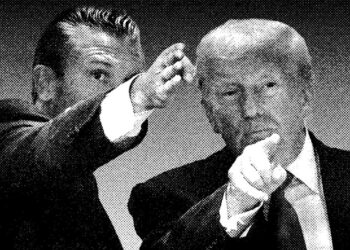For 60 years, San Diego’s Timken Museum of Art has stood in Balboa Park — a travertine-clad Modernist jewel box showcasing priceless Russian icons and masterworks from the likes of Rembrandt, Rubens, Van Dyck and Fragonard, floating among the park’s exuberant Spanish Revival fantasies. But beneath its calm exterior lies an architectural mystery that has captivated Stephen Buck and Keith York, local architecture lovers who have spent the last year obsessively piecing together evidence suggesting that the Timken’s true authorship has been misunderstood, if not deliberately obscured, since the day it opened in 1965.
Their investigation — which has caught the attention of the soon-to-expand museum, not to mention the city’s tight-knit cultural community — began with a secret. In 2013, York, founder of Modern San Diego, a digital archive devoted to the region’s Midcentury design, received a call from one of San Diego’s most respected architects, Robert Mosher. Then in his 90s, Mosher asked to meet for lunch in La Jolla. “I have something I need to tell you,” he said.
Mosher, recorded by York (who was sworn to secrecy until after Mosher’s death in 2015) recounted a story told to him decades earlier by his friend and colleague Richard Kelly, the lighting designer of some of American modernism’s most iconic buildings, including Philip Johnson’s Glass House, Louis Kahn’s Kimbell Art Museum and Mies van der Rohe’s Seagram Building. Kelly had been hired to design the lighting for the Timken. But according to Mosher, during an early meeting Walter Ames, the project’s patron, made a surprising suggestion to Kelly: “You’re the architect — why don’t you design it yourself?”
Kelly, who trained at the Yale School of Architecture but had never designed a building, found himself out of his depth, Mosher added. He turned to his close friend and frequent collaborator Johnson, who helped him sketch a concept that Kelly would refine into a design Ames approved. The plans were handed off to San Diego’s Frank L. Hope & Associates to produce the working drawings.
When completed, the rigorously composed, historically inspired stone pavilion bore all the hallmarks of Johnson and Kelly’s more than half dozen collaborations. Yet when the Timken opened, only Hope’s firm was credited. One of Hope’s architects, John R. Mock, later took credit as the leader of the design. This remained the accepted story until last December, when Buck, a medical research entrepreneur and architecture buff, stumbled on a long-ago post by York about Mosher’s tale. He couldn’t stop thinking about it.
“Why would someone like Robert Mosher, at the end of his life, make this up?” Buck asked. “If he was telling the truth, this is one of the most important uncredited works of Midcentury architecture in California.”
Buck and York joined forces, combing through Kelly’s archives at Yale (with Yale student Macarena Fernanda Diaz) and through the Timken’s own files. In addition to evidence of copious correspondence between Ames, Kelly and Johnson, they found Kelly’s detailed architectural drawings of the museum, and a 1959 contract asking Kelly to prepare elevations, plans and other design-related documents. Hope’s firm, according to a separate contract, would “prepare working drawings.” Together the body of evidence seemed to confirm much of Mosher’s story.
It also pointed to why Kelly (and potentially Johnson) was left out. In one letter, Ames wrote that “due to local political cross currents, it was advisable that all plans be filed locally.” In other words, bringing in East Coast modernists like Kelly and Johnson risked a public outcry. “Ames wanted the best design he could get,” Buck says. “But he also wanted the museum built.”
The Timken definitely feels familiar to someone who has visited several Johnson/Kelly collaborations: the bronze accents, the H-shaped pavilion, the glass walls that allow you to see straight through the building, and the pristine travertine — light-colored limestone that originated from the same quarry in Tivoli, Italy, used for Johnson’s New York State Theater (renamed the David H. Koch Theater in 2008) at Lincoln Center. All echo the minimalist precision and classical proportions of their museums across the country. At the Timken, Kelly incorporated downlighting to accentuate the building’s travertine walls, and engineered grids of soffits and louvers that wash the galleries in soft, ethereal light.
“He was experimenting — making light itself architectural,” says York. This was a trademark of Kelly’s, notes Dietrich Neumann, professor of the history of modern architecture and urbanism at Brown University and author of “The Structure of Light: Richard Kelly and the Illumination of Modern Architecture.” “He emphasized materials in a very skillful way. His lighting creates spatial depth. You get a different idea of what the architecture consists of.” Neumann notes that Johnson liked to exclaim: “Kelly is my guru. He’s the greatest lighting designer ever.”
Noted Buck: “There’s nothing in Frank Hope’s body of work that resembles this.” Hope’s firm is best known for its designs of McGill Hall at UC San Diego, the Union-Tribune Building in Mission Valley, and the all-concrete San Diego Stadium, later known as Qualcomm Stadium.
When Buck and York presented their findings to the Timken’s leadership earlier this year, the initial response was enthusiastic. But as the museum began its own review, the tone grew more cautious. Trustees revisited Buck and York’s research and conducted checks in the Timken’s archives. Executive director Megan Pogue later summarized their position in a letter to the researchers:
“Based on these findings, we reached the unfortunate conclusion that Mr. Johnson was not ultimately involved in the building’s design, although the specific architect or architects within Frank Hope & Associates responsible for the final design seem to remain unidentified. We continue to welcome and encourage further scholarly investigation into this question, particularly given that John Mock has long been credited as the architect — an attribution he personally confirmed in recent years.”
When asked later why the museum didn’t confirm or deny Kelly’s connection, Pogue noted, “Everything in our files is that he was limited to the lighting.” When pressed on the research unearthed at Yale, she acknowledged, “we were so focused on Philip Johnson I don’t know that we did as deep a dive on this issue.”
“I can find no reason why they wouldn’t want to look through this research [at Yale] and come to their own conclusion,” responded Buck.
Behind the scenes, practical considerations loom. The Timken is preparing to launch an underground expansion designed by Gensler, which will double its square footage and provide much-needed new exhibition, office and learning spaces. It’s a process that has taken seven years to navigate through the city’s (and Balboa Park’s) public process. The adjacent San Diego Museum of Art is about to embark on its own expansion, replacing Mosher’s west wing with a design by Norman Foster.
“Any new attention, especially about the building’s authorship, could reignite old debates,” Pogue said in an earlier interview. “We’re fascinated by this history, but we have to be careful about how it’s shared.” After consulting with the board, Pogue later noted that proof of a new architect, particularly someone of Johnson’s stature, “could be really good for the museum.”
The museum’s nebulous, careful positioning in many ways mirrors the politics that may have buried Kelly’s and Johnson’s involvement six decades ago. In the early 1960s, Ames faced fierce opposition from civic groups, who decried modernism as a threat to Balboa Park’s Spanish heart. To get his project approved, he appears to have localized the credit.
The post Who really designed this San Diego museum? An architectural whodunit appeared first on Los Angeles Times.




